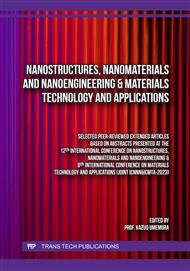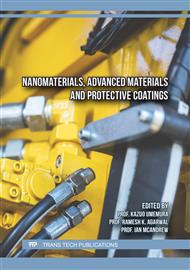p.15
p.21
p.35
p.41
p.49
p.55
p.63
p.69
p.75
Glass Transition Temperature and Mechanical Properties of Poly(Ethylene Carbonate)/Organoclay Composites
Abstract:
Poly(ethylene carbonate) (PEC) is a form of aliphatic polycarbonate, a biodegradable polymer made via the copolymerization of carbon dioxide and epoxides. The poor thermal stability and mechanical properties of these aliphatic carbonates are attributed to the carbon structure's flexibility, which restricts their applications. By combining PEC with organoclay CP180, this study addressed the weaknesses of PEC with organoclay addition. A physical blending technique was employed to generate PEC/organoclay composites with a 10-50 wt.% ratio of organoclay. The blended material's thermal characteristics were analyzed using differential scanning calorimetry (DSC), and the mechanical characteristics were measured using a universal tensile machine. The Field Emission Scanning Electron Microscopy (FESEM) analysis determined the blends' morphology. Before the torque value for all curves grew with the addition of CP180 material to the PEC matrix, it became constant. It reached a high value due to the shear-thickening behavior of the PEC matrix with organoclay addition. Tg of PEC increased by more than 7°C by 40 wt.% organoclay addition, as evident in the hindrance of PEC flexibility, significantly increased the toughness of this PEC. From the FESEM images, the formation of large silicate starts to aggregate effectively, lowering the interfacial area between organoclay and PEC as the clay content continues to rise, as shown by 50 wt.% organoclay addition.
Info:
Periodical:
Pages:
49-54
Citation:
Online since:
March 2024
Keywords:
Price:
Сopyright:
© 2024 Trans Tech Publications Ltd. All Rights Reserved
Share:
Citation:



